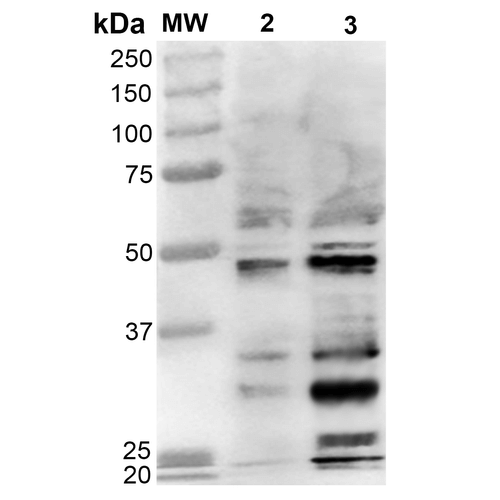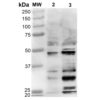Anti-Dibromo-tyrosine Mouse Monoclonal Antibody (56608)
$441.00
| Host | Quantity | Applications | Species Reactivity | Data Sheet | |
|---|---|---|---|---|---|
| Mouse | 100 ug | WB,ICC/IF,ELISA | Species Independent |  |
SKU: 56608
Categories: Antibody Products, Heat Shock and Stress Protein Antibodies, Products
Overview
Product Name Anti-Dibromo-tyrosine Mouse Monoclonal Antibody (56608)
Description Anti-Dibromo-tyrosine Mouse Monoclonal Antibody
Target Dibromo-tyrosine
Species Reactivity Species Independent
Applications WB,ICC/IF,ELISA
Host Mouse
Clonality Monoclonal
Clone ID 9F12
Isotype IgG1
Immunogen Synthetic 3,5-Dibromotyrosine conjugated to Keyhole Limpet Hemocyanin (KLH).
Properties
Form Liquid
Concentration 1 mg/mL
Formulation PBS pH 7.4, 50% glycerol, 0.09% Sodium azide
Buffer Formulation Phosphate Buffered Saline
Buffer pH pH 7.4
Buffer Anti-Microbial 0.09% Sodium azide
Buffer Cryopreservative 50% glycerol
Format Purified
Purification Protein G Purified
Background Dibromotyrosine is a major product of protein oxidation due to oxidative stress. Neutrophil myeloperoxidase (MPO) and eosinophil peroxidase (EPO), enzymes expressed in granulocytes, catalyze the formation of hypobromous acid (HOBr) from hydrogen peroxide (H2O2) and bromide ion (Br-). HOBr reacts with tyrosine residues in proteins to produce 3, 5-dibromotyrosine. (1)
Specificity Information
Specificity Specific for 3,5-Dibromo-tyrosine. Does not cross-react with Nitrotyrosine.
Target Name Dibromo-tyrosine
Target ID Dibromo-tyrosine
Alternative Names 3,5-Dibromo-tyrosine, 3,5-dibromotyrosine, Dibromotyrosine, Dibromo-tyrosine, DiBrY, Dibromotyrosine (DiBrY), Dibromo-Tyrosine (DiBrY), Dibromo-tyrosine [DiBrY]
Research Areas Cancer | Oxidative Stress | Protein Oxidation | Cell Signaling | Post-translational Modifications | Oxidation
Application Images




Description Western Blot analysis of 3, 5-Dibromotyrosine-BSA Conjugate showing detection of 67 kDa Dibromo-tyrosine protein using Mouse Anti-Dibromo-tyrosine Monoclonal Antibody, Clone 9F12 . Lane 1: Molecular Weight Ladder (MW). Lane 2: BSA. Lane 3: Nitrosylated-BSA. Lane 4: Dibromotyrosine-BSA. Load: 1 µg. Block: 5% Skim Milk in TBST. Primary Antibody: Mouse Anti-Dibromo-tyrosine Monoclonal Antibody at 1:1000 for 2 hours at RT. Secondary Antibody: Goat Anti-Mouse IgG: HRP at 1:2000 for 60 min at RT. Color Development: ECL solution for 5 min in RT. Predicted/Observed Size: 67 kDa.

Description Western Blot analysis of Human Cervical cancer cell line (HeLa) lysate showing detection of Dibromo-tyrosine protein using Mouse Anti-Dibromo-tyrosine Monoclonal Antibody, Clone 9F12 . Lane 1: Molecular Weight Ladder (MW). Lane 2: HeLa cell lysate. Lane 3: H2O2 treated HeLa cell lysate. Load: 12 µg. Block: 5% Skim Milk in TBST. Primary Antibody: Mouse Anti-Dibromo-tyrosine Monoclonal Antibody at 1:1000 for 2 hours at RT. Secondary Antibody: Goat Anti-Mouse IgG: HRP at 1:2000 for 60 min at RT. Color Development: ECL solution for 5 min in RT.

Description Immunocytochemistry/Immunofluorescence analysis using Mouse Anti-Dibromo-tyrosine Monoclonal Antibody, Clone 9F12 . Tissue: Embryonic kidney epithelial cell line (HEK293). Species: Human. Fixation: 5% Formaldehyde for 5 min. Primary Antibody: Mouse Anti-Dibromo-tyrosine Monoclonal Antibody at 1:50 for 30-60 min at RT. Secondary Antibody: Goat Anti-Mouse Alexa Fluor 488 at 1:1500 for 30-60 min at RT. Counterstain: Phalloidin Alexa Fluor 633 F-Actin stain; DAPI (blue) nuclear stain at 1:250, 1:50000 for 30-60 min at RT. Magnification: 20X (2X Zoom). (A,C,E,G) - Untreated. (B,D,F,H) - Cells cultured overnight with 50 µM H2O2. (A,B) DAPI (blue) nuclear stain. (C,D) Phalloidin Alexa Fluor 633 F-Actin stain. (E,F) Dibromo-tyrosine Antibody. (G,H) Composite. Courtesy of: Dr. Robert Burke, University of Victoria.
Handling
Storage This antibody is stable for at least one (1) year at -20°C. Avoid multiple freeze-thaw cycles.
Dilution Instructions Dilute in PBS or medium which is identical to that used in the assay system.
Application Instructions WB (1:1000); ICC/IF (1:50); ELISA (1:1000); optimal dilutions for assays should be determined by the user.
References & Data Sheet
Data Sheet  Download PDF Data Sheet
Download PDF Data Sheet
 Download PDF Data Sheet
Download PDF Data Sheet






